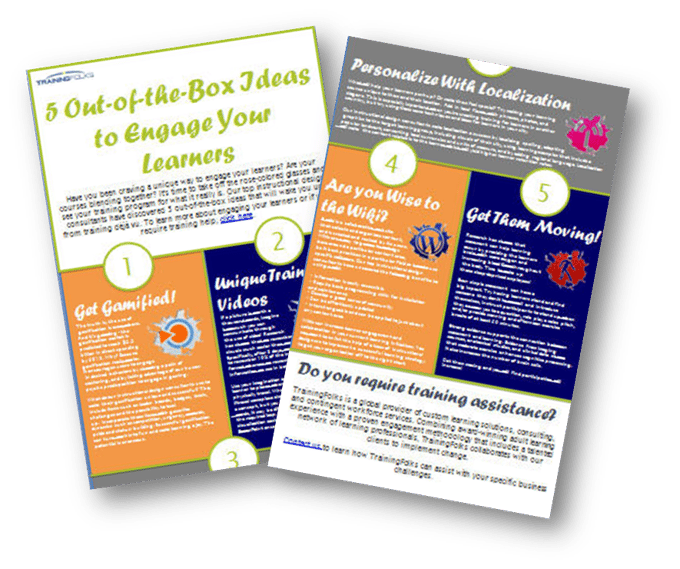Experienced instructional designers understand the importance of motivating and engaging their learners. Have you been craving a unique way to engage your learners in 2016? Are your courses blending together? It's time to take off the rose-colored glasses and see your training program for what it really is!
Our top instructional design consultants have discovered 5 out-of-the-box ideas that  will engage your learners and wake them up from training déjà vu. Download our infographic today to find out how!
will engage your learners and wake them up from training déjà vu. Download our infographic today to find out how!
The good news is that while you can’t make a person learn, you can create an environment that is more conducive to learning. You do this by tapping into the learner’s motivation.
Motivating with Positive Reinforcement
Here are three corporate training tips for using positive reinforcement to have learners feel the power:
1. The power of words. Using positive expressions, such as "yes", "good", "that's interesting", even, "close, that's an interesting suggestion" are all ways to encourage participation. Answering in a group, even a group of peers, can be intimidating. As the leader of the exercise, be consistent in noting participants and encouraging their enthusiasm.
2. The power of body language. Using your body to encourage participatants includes things like leaning forward and making eye contact, giving a thumbs up, smiling, nodding your head, and even giving the OK sign are all ways to signal that the learner is doing the right thing by participating. Having a willing group of learners is contagious.
3. The power of being right. If exercises are too difficult, and activities are constructed to  "catch" people, you are setting the learners up for failure. Instead, set the participants up for success. It's easier to get people to repeat and try new things if they feel that they understand the goals and they can correctly accomplish the task. Dividing complex tasks into simpler components can effectively guide the users through the exercise.
"catch" people, you are setting the learners up for failure. Instead, set the participants up for success. It's easier to get people to repeat and try new things if they feel that they understand the goals and they can correctly accomplish the task. Dividing complex tasks into simpler components can effectively guide the users through the exercise.
Motivate with Chunking
Chunking refers to the strategy of breaking down information into bite-sized pieces so that human brain can easily digest the new information. When information is organized and grouped together, it is making the most efficient use of our short-term memory. When information is chunked into groups, the brain can process them easier and faster because our working memory, the area of our brain which manipulates information, holds a limited amount of data at one time.
Use your chunking strategy while determining the content hierarchy of a course. Separate your eLearning course content into modules, lessons and then smaller topics. Maintain a logical and progressive order as you do this. This process follows a funnel-like process as you begin with the masses and work yourself down to the particulars.
-
Content to Modules: Start with large chunks of conceptually related content and use these as your modules. There are numerous organizational strategies to use during this stage, including simple to complex, alphabetical, cause and effect, sequential, etc.
-
Modules to Lessons: Divide modules into smaller related chunks and these will serve as your lessons. Continue with this process until content is broken down to the topic level. When you divide your eLearning course into topics and themes, your learner won’t feel lost in a sea of unrelated and seemingly irrelevant information.
-
Lessons to Screen: Once you have a solid module-lesson structure in place, a successful instructional designer should be cognizant of how the content appears on screen. The content should have a rational flow, starting from basic and broad concepts and then progressively advancing into more complex ideas. Each screen should consist of one chunk of related information. Avoid presenting multiple topics at one time and support content with various resources, including images, video, audios, etc. In fact, complementing any presentation with audio and video techniques increases retention rates and learner engagement.
Motivate Through Games (Gamification)
According to Forbes, “The most sought after employees have a tendency to seek out challenges, to extend and exercise their capabilities, to explore and to learn.” There are four factors that we have seen in common with the upmost motivated employees – feeling intelligent, feeling successful, feeling socially valued, and a sense of structure. Those factors come into play when gamification in training is executed properly. For example, learners who complete levels or earn badges feel intelligent, successful and enjoy a strong sense of accomplishment for completing their assigned task. They also feel socially valued when they achieve a certain “social status” through the participation in their training.
to extend and exercise their capabilities, to explore and to learn.” There are four factors that we have seen in common with the upmost motivated employees – feeling intelligent, feeling successful, feeling socially valued, and a sense of structure. Those factors come into play when gamification in training is executed properly. For example, learners who complete levels or earn badges feel intelligent, successful and enjoy a strong sense of accomplishment for completing their assigned task. They also feel socially valued when they achieve a certain “social status” through the participation in their training.
Also, the structure in gamification helps to motivate the learner because they can see they are making progress. When you motivate your employees properly and the right work gets done in the right way; your organization runs efficiently. Your organization becomes defined by its continuous productivity advancements, wide spread innovation, and its ability to adapt to the changing business environment.
Read more about gamification...
Motivate with Visualization
If a picture is worth a thousand words, imagine how much you can communicate through the use of video! Research has shown that we remember visuals much easier than words. Specifically, after 3 days, we tend to remember 10% of the information we see in word format whereas we remember 65% of the information we see in both pictures and word. Use videos (as per title) as a transportation vehicle.
Use your imagination and envision transporting the learner to places where he or she could not physically travel. When you are asking the learner to “travel someplace else in their mind” and to visualize a concept, but you only describe that concept in words, it may be difficult for some learners to make the required leap. Videos will make concept visualization easier. Let’s end the death by PowerPoint once and for all.
These are a few examples you can use to motivate and engage your learners. It's imperative to find the right angle that works best for learners at your organization. A motivated and engaged learner will learn!
Looking for an instructional designer to create engaging and motivating content at your organization? Content the experts at TrainingFolks today!


